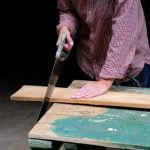PVA glue, also known as polyvinyl acetate glue, is a versatile adhesive that finds widespread use in woodworking projects. What is PVA glue used for in woodwork? This article aims to answer that question by delving into the various properties, application techniques, and benefits of using PVA glue in woodworking.
PVA glue has become a staple in the woodworking industry due to its strong adhesive properties and ease of use. It serves as a reliable bonding agent for joining wood pieces together and laminating wood surfaces. Its compatibility with a wide range of wood types makes it a go-to choice for craftsmen and DIY enthusiasts alike.
In this comprehensive guide, we will explore the adhesive properties of PVA glue, its applications in different woodworking projects, bonding strength in wood joints, compatibility with various wood types, weather resistance for outdoor projects, and safety measures when handling the adhesive. Additionally, we will discuss alternative uses of PVA glue beyond woodworking in arts, crafts, and do-it-yourself (DIY) projects.
So whether you’re a seasoned woodworker or just starting out with your first project, understanding the significance of PVA glue is crucial for achieving professional results.
Properties of PVA Glue
PVA (polyvinyl acetate) glue is a popular adhesive used in woodworking due to its excellent adhesive properties and numerous benefits. One of the key properties of PVA glue is its strong bonding capability, which makes it an ideal choice for joining wood pieces together.
This type of glue creates a durable and long-lasting bond, ensuring that the woodwork remains stable and secure over time. Additionally, PVA glue dries clear, making it perfect for projects where a seamless finish is desired.
In addition to its adhesive properties, PVA glue offers several benefits when used in woodwork. It is non-toxic and easy to clean up with water, making it safe to use and convenient for everyday woodworking projects. PVA glue also has a relatively quick drying time, allowing for efficient work progress without compromising bonding strength. Its affordability and availability in various formulations make it a versatile option for both professional woodworkers and DIY enthusiasts alike.
When using PVA glue in woodwork, it is important to consider the specific application techniques that will result in optimal bonding. Whether applying the glue on porous or non-porous surfaces, proper application methods such as spreading the glue evenly and clamping the pieces together are essential for achieving strong and reliable bonds. Understanding how to effectively apply PVA glue to different woodworking projects can lead to successful outcomes and high-quality results.
Overall, the adhesive properties and benefits of using PVA glue in woodwork make it an invaluable tool for joining wood pieces together seamlessly and securely. Whether working on large-scale woodworking projects or smaller DIY endeavors, the versatility and reliability of PVA glue make it a go-to option for craftsmen looking to achieve professional-grade results.
Application Techniques
When it comes to using PVA glue in woodwork, the proper application techniques are crucial for achieving strong and reliable bonds. Whether you are working on a small woodworking project or a large furniture piece, knowing how to apply PVA glue correctly can make a significant difference in the quality and durability of the finished product.
Brush Application
One of the most common methods for applying PVA glue to wood is by using a brush. This technique allows for the even distribution of the adhesive across the surface, ensuring that the bond is uniform and secure. When using a brush, it is important to work quickly and efficiently to prevent the glue from drying out before assembly.
Roller Application
For larger woodworking projects, such as panel assembly or laminating surfaces, using a roller to apply PVA glue can be highly effective. This method enables faster coverage and ensures that there are no gaps or uneven spots in the bonding area.
Clamp Pressure
Regardless of the application technique used, applying adequate pressure with clamps or weights is essential for achieving a strong bond with PVA glue. Proper clamping ensures that the pieces are held together tightly while the adhesive cures, resulting in a durable and long-lasting joint.
Understanding how to apply PVA glue effectively to different woodworking projects is key to achieving professional results. By mastering these application techniques, woodworkers can harness the full bonding potential of PVA glue and create high-quality woodwork that stands the test of time.
Bonding Strength
PVA glue, also known as polyvinyl acetate glue, is a popular adhesive in woodwork due to its strong bonding capabilities. Whether it’s for joining wood pieces together or laminating wood surfaces, PVA glue is known for creating durable and reliable bonds.
When using PVA glue for wood joints, it is important to ensure that the surfaces are clean and free of any dust or debris. Applying a thin, even layer of PVA glue to both surfaces before pressing them together will result in a strong bond. The glue sets relatively quickly, but clamping the joint for a few hours can further enhance the strength of the bond.
In addition to joining wood pieces, PVA glue is also effective in laminating wood surfaces. This process involves applying PVA glue to thin layers of wood veneer and then pressing them together to create a composite material. The bonding strength of PVA glue ensures that the laminated wood surfaces remain firmly attached even under stress or pressure.
Moreover, PVA glue can be used on various types of woods including hardwoods and softwoods. It is essential to note that while PVA glue provides strong bonding capabilities, it may not be suitable for certain oily or exotic wood types. Therefore, it is crucial to test the compatibility of PVA glue with specific wood types before using it in your woodworking projects.
Compatibility With Wood Types
PVA glue, also known as polyvinyl acetate glue, is widely used in woodwork due to its versatility and strong adhesive properties. When it comes to the compatibility of PVA glue with different types of wood, it is important to consider the porosity and moisture content of the wood. Generally, PVA glue is suitable for use on a variety of wood types including softwoods like pine and fir, as well as hardwoods such as oak, maple, and cherry.
One of the key benefits of using PVA glue in woodwork is its ability to create strong and durable bonds between pieces of wood. Whether you are working on woodworking joints or laminating wood surfaces, PVA glue provides excellent bonding strength that helps ensure the structural integrity of your project. Additionally, PVA glue dries clear and is paintable, making it a great choice for woodworking projects that require a seamless finish.
While PVA glue is compatible with many types of wood, there are some limitations to be aware of. For example, certain oily exotic woods may not bond well with PVA glue due to their natural oils preventing proper adhesion. In these cases, it is advisable to use alternative adhesives that are specifically formulated for oily woods. Overall, understanding the compatibility of PVA glue with different wood types is crucial for achieving successful and long-lasting woodworking projects.
Waterproof and Weather Resistance
PVA glue is a popular adhesive commonly used in woodworking due to its versatile properties and strong bonding capabilities. When it comes to outdoor woodwork, the water-resistant properties of PVA glue make it a suitable choice for various projects. Whether it’s building outdoor furniture, decking, or garden structures, PVA glue can provide reliable adhesion and durability in challenging weather conditions.
Waterproof Properties
One of the main advantages of using PVA glue in outdoor woodwork is its waterproof nature. This type of glue forms a strong bond that can withstand exposure to moisture, rain, and humidity without compromising its adhesive strength. This makes it an ideal choice for outdoor applications where wood needs to be protected from the elements.
Suitability for Outdoor Projects
PVA glue is well-suited for outdoor woodwork projects such as building wooden decks, fences, and garden furniture. Its ability to resist water and weather-related damage ensures that the bonded joints remain intact and stable over time. Additionally, PVA glue can be used in combination with other waterproofing techniques to enhance the longevity of outdoor woodwork projects.
Limitations and Considerations
While PVA glue offers reliable water resistance, it’s important to note that extended exposure to direct sunlight and extreme temperatures may impact its performance over time. Therefore, when using PVA glue for outdoor woodwork, it’s essential to consider the specific environmental conditions and take appropriate measures to protect the bonded surfaces from prolonged sun exposure or extreme temperature fluctuations.
Safety Measures
PVA glue, also known as polyvinyl acetate glue, is a popular adhesive used in woodworking. Its versatility and ease of use make it a go-to choice for woodworkers of all skill levels. However, it is important to understand the proper safety precautions and handling instructions when working with PVA glue to ensure a safe and successful woodworking project.
One of the most important safety measures when using PVA glue in woodwork is to wear protective gear, such as gloves and safety goggles. This can help prevent skin irritation and eye contact with the adhesive, which can cause discomfort or injury. Additionally, working in a well-ventilated area can help minimize exposure to potentially harmful fumes that may be released during the drying process.
When handling PVA glue, it is crucial to follow the manufacturer’s instructions for application and cleanup. This includes storing the adhesive in a cool, dry place and ensuring that the container is tightly sealed after use to prevent drying out or contamination. Proper disposal of leftover glue and cleaning tools promptly with water are also essential steps in handling PVA glue safely.
It is also important to keep PVA glue out of reach of children and pets, as ingestion or misuse can lead to health hazards. By following these safety measures and handling instructions, woodworkers can effectively utilize PVA glue in their projects while minimizing any potential risks associated with its use.
| Safety Measures | Handling Instructions |
|---|---|
| Wear protective gear such as gloves and safety goggles | Follow manufacturer’s instructions for application and cleanup |
| Work in a well-ventilated area | Store adhesive in a cool, dry place and seal container tightly after use |
| Keep out of reach of children and pets | Clean tools promptly with water after use |
Alternative Uses
In conclusion, PVA glue is a highly versatile adhesive that is widely used in woodwork for its strong bonding properties and ease of application. From basic joinery to laminating wood surfaces, PVA glue offers excellent adhesion and ensures durable results. Its compatibility with various wood types and waterproof properties also make it a popular choice for outdoor woodworking projects.
Beyond woodwork, PVA glue has found numerous alternative uses in arts, crafts, and DIY projects. Its versatility allows it to be used for paper crafts, fabric projects, and even as a sealant for porous materials. With its non-toxic nature and ease of use, PVA glue has become a staple in the crafting community for its ability to bond various materials together securely.
Overall, the significance of PVA glue in both woodwork and other creative endeavors cannot be overstated. Its strong adhesive properties, compatibility with different materials, and versatility make it an essential tool for any woodworking or crafting enthusiast. Whether it’s for constructing furniture or creating art pieces, PVA glue continues to be an invaluable resource for achieving reliable and long-lasting bonds in various projects.
Frequently Asked Questions
Does PVA Glue Harden Wood?
PVA glue, also known as wood glue, does harden when used on wood. When applied and allowed to dry, it forms a strong bond with the wood, providing stability and durability to the joint.
Is PVA Any Good for Wood?
PVA glue is indeed a good choice for woodworking projects. It is easy to use, dries clear, and provides a strong bond with most types of wood. It is also cost-effective and readily available in stores.
How Strong Is PVA Glue on Wood?
The strength of PVA glue on wood joints is quite impressive. When properly applied and allowed to dry, it creates a durable bond that can withstand the normal stress and strain that wooden objects endure. This makes it an ideal choice for woodworking projects both big and small.

Hi everyone! I’m a woodworker and blogger, and this is my woodworking blog. In my blog, I share tips and tricks for woodworkers of all skill levels, as well as project ideas that you can try yourself.





